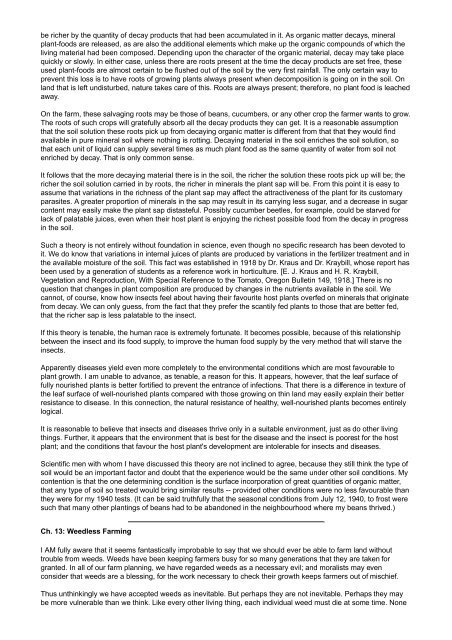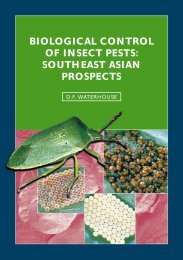Ploughman's Folly Ploughman's Folly - EcoPort
Ploughman's Folly Ploughman's Folly - EcoPort
Ploughman's Folly Ploughman's Folly - EcoPort
Create successful ePaper yourself
Turn your PDF publications into a flip-book with our unique Google optimized e-Paper software.
e richer by the quantity of decay products that had been accumulated in it. As organic matter decays, mineral<br />
plant-foods are released, as are also the additional elements which make up the organic compounds of which the<br />
living material had been composed. Depending upon the character of the organic material, decay may take place<br />
quickly or slowly. In either case, unless there are roots present at the time the decay products are set free, these<br />
used plant-foods are almost certain to be flushed out of the soil by the very first rainfall. The only certain way to<br />
prevent this loss is to have roots of growing plants always present when decomposition is going on in the soil. On<br />
land that is left undisturbed, nature takes care of this. Roots are always present; therefore, no plant food is leached<br />
away.<br />
On the farm, these salvaging roots may be those of beans, cucumbers, or any other crop the farmer wants to grow.<br />
The roots of such crops will gratefully absorb all the decay products they can get. It is a reasonable assumption<br />
that the soil solution these roots pick up from decaying organic matter is different from that that they would find<br />
available in pure mineral soil where nothing is rotting. Decaying material in the soil enriches the soil solution, so<br />
that each unit of liquid can supply several times as much plant food as the same quantity of water from soil not<br />
enriched by decay. That is only common sense.<br />
It follows that the more decaying material there is in the soil, the richer the solution these roots pick up will be; the<br />
richer the soil solution carried in by roots, the richer in minerals the plant sap will be. From this point it is easy to<br />
assume that variations in the richness of the plant sap may affect the attractiveness of the plant for its customary<br />
parasites. A greater proportion of minerals in the sap may result in its carrying less sugar, and a decrease in sugar<br />
content may easily make the plant sap distasteful. Possibly cucumber beetles, for example, could be starved for<br />
lack of palatable juices, even when their host plant is enjoying the richest possible food from the decay in progress<br />
in the soil.<br />
Such a theory is not entirely without foundation in science, even though no specific research has been devoted to<br />
it. We do know that variations in internal juices of plants are produced by variations in the fertilizer treatment and in<br />
the available moisture of the soil. This fact was established in 1918 by Dr. Kraus and Dr. Kraybill, whose report has<br />
been used by a generation of students as a reference work in horticulture. [E. J. Kraus and H. R. Kraybill,<br />
Vegetation and Reproduction, With Special Reference to the Tomato, Oregon Bulletin 149, 1918.] There is no<br />
question that changes in plant composition are produced by changes in the nutrients available in the soil. We<br />
cannot, of course, know how insects feel about having their favourite host plants overfed on minerals that originate<br />
from decay. We can only guess, from the fact that they prefer the scantily fed plants to those that are better fed,<br />
that the richer sap is less palatable to the insect.<br />
If this theory is tenable, the human race is extremely fortunate. It becomes possible, because of this relationship<br />
between the insect and its food supply, to improve the human food supply by the very method that will starve the<br />
insects.<br />
Apparently diseases yield even more completely to the environmental conditions which are most favourable to<br />
plant growth. I am unable to advance, as tenable, a reason for this. It appears, however, that the leaf surface of<br />
fully nourished plants is better fortified to prevent the entrance of infections. That there is a difference in texture of<br />
the leaf surface of well-nourished plants compared with those growing on thin land may easily explain their better<br />
resistance to disease. In this connection, the natural resistance of healthy, well-nourished plants becomes entirely<br />
logical.<br />
It is reasonable to believe that insects and diseases thrive only in a suitable environment, just as do other living<br />
things. Further, it appears that the environment that is best for the disease and the insect is poorest for the host<br />
plant; and the conditions that favour the host plant's development are intolerable for insects and diseases.<br />
Scientific men with whom I have discussed this theory are not inclined to agree, because they still think the type of<br />
soil would be an important factor and doubt that the experience would be the same under other soil conditions. My<br />
contention is that the one determining condition is the surface incorporation of great quantities of organic matter,<br />
that any type of soil so treated would bring similar results -- provided other conditions were no less favourable than<br />
they were for my 1940 tests. (It can be said truthfully that the seasonal conditions from July 12, 1940, to frost were<br />
such that many other plantings of beans had to be abandoned in the neighbourhood where my beans thrived.)<br />
Ch. 13: Weedless Farming<br />
I AM fully aware that it seems fantastically improbable to say that we should ever be able to farm land without<br />
trouble from weeds. Weeds have been keeping farmers busy for so many generations that they are taken for<br />
granted. In all of our farm planning, we have regarded weeds as a necessary evil; and moralists may even<br />
consider that weeds are a blessing, for the work necessary to check their growth keeps farmers out of mischief.<br />
Thus unthinkingly we have accepted weeds as inevitable. But perhaps they are not inevitable. Perhaps they may<br />
be more vulnerable than we think. Like every other living thing, each individual weed must die at some time. None






